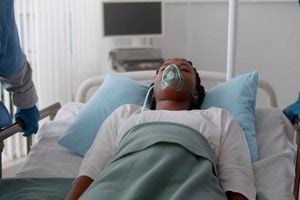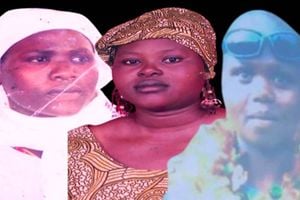How blood donation is saving mothers’ lives during delivery

Jerry Osumba, the officer in charge of Homa Bay County Teaching and Referral Hospital blood bank, inspects a freezer used to store donated blood on July 5,2024.
What you need to know:
- According to the Kenya Demographic Health Survey 2023 report, Homa Bay's maternal mortality rate is 583 per 100,000 live births compared with the national average of 488.
Homa Bay is among counties struggling with high prevalence of maternal mortality, with many women dying while giving birth due to various factors including lack of blood in health facilities and delayed referrals. Others are health workers’ strikes and failure by pregnant women to embrace skilled delivery.
According to the Kenya Demographic Health Survey 2023 report, the county’s maternal mortality rate is 583 per 100,000 live births compared with the national average of 488.
The county’s Health Chief Officer Kevin Osuri says that until recently, many cases of maternal mortality resulted from lack of blood, with most women dying because of postpartum hemorrhage (heavy bleeding after giving birth).
The county has been grappling with blood shortage, and this has seen expectant women in need of blood transfusion waiting for long to get help.
“Their family members would be asked to donate blood to replace what was in stock before a patient received blood. In certain circumstances, they would be referred to Kisumu to save their lives," Dr Osuri says.
But the narrative is changing, thanks to improved blood donation in the county since early last year. Health facilities in the county now have constant supply of blood.
Over the past six months, the county has collected 3,558 pints of blood mostly from students in secondary schools and tertiary institutions. The other sources include churches, individuals who volunteer and the people who donate blood for replacement when their family members are hospitalised.
Dr Osuri says the devolved unit has eliminated maternal deaths associated with postpartum hemorrhage by ensuring there is constant blood supply in health facilities.
And following the improved services for blood transfusion, Homa Bay Teaching and Referral Hospital has been recognised as the most improved satellite blood bank facility in Kenya and the top facility in blood banking management.
The prestigious Fadhili Awards, presented by a consortium of the nation's leading blood banking agencies including Ministry of Health, Kenya Blood Banking Management System (Damu-Ke), Kenya Transfusion and Transplant Services and Kenya Tissue and Transplant Authority, honoured the county’s teaching and referral hospital for its outstanding transformation.
This transformation has enabled the hospital to support 24 other subsidiary facilities in the county and neighbouring counties, resulting in a substantial decrease in mortalities caused by haemorrhage,
Dr Osuri explains that Homa Bay got the recognition because of reforms introduced at the county’s blood bank.
He adds that there has been improvement in the quality of services offered at the blood bank.
“The amount of blood collected and stored at the facility has also increased over the last one year.”
Records at the hospital shows that the county has set a target to collect at least 11,400 pints of blood every year.
The data further reveals that the county referral hospital uses most blood at 71 per cent. Homa Bay has eight private facilities, nine sub-county hospitals, four level four hospitals and three faith-based hospitals, which collectively use at least 25 per cent of the blood collected.
Mr Jerry Osumba, the medical officer in charge of blood transfusion in the county, explains that donation begins by a donor filling in a questionnaire that was developed by Kenya Tissue and Transplant Authority. This helps in determining the eligibility of donors to donate blood. The questionnaire contains donor information, health status and other physical signs in the body.
Mr Osumba says donors are identified using a unique number (punch number) that is later used to trace the blood.
All the information is put in a digital system called Damu Ke, which can be accessed by health workers from other regions as well.
"Blood is put in bags and taken to the blood bank. Samples are then collected from each bag for testing," he says.
Just before taking blood for screening, medics at the facility conduct component separation, where blood components are separated by centrifugation. It helps in tracing diseases.
The top layer, containing the plasma, and the bottom layer, containing the red blood cells, are extracted. The buffy coat layer between the red blood cells and plasma contains platelets and white blood cells.
Counties in Nyanza rely on a regional laboratory in Kisumu, where all the samples are taken for screening. Donated blood is screened for syphilis; Hepatitis B, Hepatitis C and HIV, which can be transmitted through an otherwise unsafe blood.
Mr Osumba says the process normally takes up to four days before they can get to know whether the blood they collected can be used by a patient or not.
"We receive the results via a digital format. Using the identification codes used to identify donors, we are able to generate and print stickers and put them on blood bags kept in the freezer," he says.
Health workers from different hospitals later collect blood upon reading labels on each bag.
The stickers contain information such as when the blood was donated, temperature under which it was stored and transported and screening results. If a test result is positive, the donation is discarded.
Mr Osumba says some public health facilities in the county including Rachuonyo South Sub-county Hospital, Ndhiwa and Mbita can now do blood replacement.
Dr Osuri says Homa Bay now has an adequate supply of blood and it has been helping patients in other counties. "This is a milestone that we have achieved as a county. During emergencies, we have saved lives by helping hospitals in neighbouring counties to get blood," he says.
He urges more residents to continue donating blood to help in the fight against maternal mortality.





